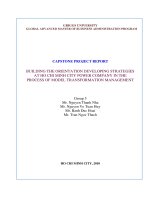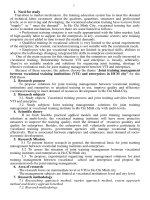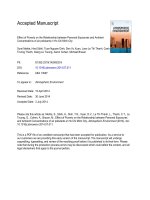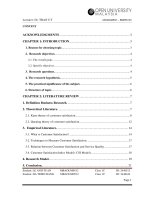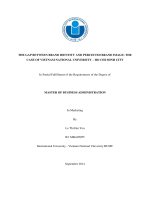Relationship between corporation social responsibility, brand equity, company reputation and customer company identification in ho chi minh city hotel industry
Bạn đang xem bản rút gọn của tài liệu. Xem và tải ngay bản đầy đủ của tài liệu tại đây (1.25 MB, 75 trang )
UNIVERSITY OF ECONOMICS HO CHI MINH CITY
INTERNATIONAL SCHOOL OF BUSINESS
TRAN ANH TRUC
RELATIONSHIP BETWEEN CORPORATE SOCIAL
RESPONSIBILITY, BRAND EQUITY, COMPANY
REPUTATION, AND CUSTOMER-COMPANY
IDENTIFICATION IN HO CHI MINH CITY HOTEL
INDUSTRY
MASTER OF BUSINESS (Honours)
SUPERVISOR: LUU TRONG TUAN, PhD
Ho Chi Minh City - 2014
i
LIST OF FIGURES
Figure 2.1: Conceptual model of CSR, REP, BRE, and CCI
16
Figure 3.1: Research process
18
Figure 4.1: Confirmatory factor analysis for CSR, BRE, REP
37
Figure 4.2: Confirmatory factor loading for CCI
38
Figure 4.3: Saturated model
39
Figure 4.4: Structural model
42
Figure 4.5: Competitive model
43
ii
LIST OF TABLES
Table 3.1: Adopted measurement scale
23
Table 3.2: Cronbach’s Alpha result for pilot test
27
Table 3.3: Exploratory factors analysis result for pilot test
29
Table 4.1: Cronbach’s alpha result
32
Table 4.2: Exploratory factors analysis result for main survey
34
Table 4.3: CFA result for CSR, REP, and BRE
36
Table 4.4 CFA result of CCI
37
Table 4.5: CFA result for Saturated models
39
Table 4.6: Relationship between constructs in saturated model
40
Table 4.7: SEM result for structural model
41
Table 4.8: Relationship between constructs in structural model
41
Table 4.9: SEM result for Competitive model
43
Table 4.10: Relationship between constructs in competitive model
44
Table 4.11: Bootstrap for structural model
45
Table 4.12: Hypothesis testing result
46
iii
LIST OF ABBREVIATIONS
The following table describes the significant of various abbreviations used throughout the
thesis.
Abbreviation
Meaning
CSR
Corporate Social Responsibility
BRE
Brand equity
REP
Reputation
CCI
Customer-company identification
SEM
Structural equation modeling
CFA
Confirmatory factor analysis
ACKNOWLEDGEMENT
I gratefully acknowledge the constructive comments provided by Luu Trong Tuan,
Phd. His ideas and suggestions play an important role in my research orientation.
I would like to thank my colleagues who work in hotel and travel company, who
gave me much valuable advice in the early stages of this work. A lot of friends of friends
who help me deliver my survey. And people who save time to reply my questionnaires.
In addition, I want to thank you for my team at Trails of Indochina, who stood in
the breach when I concentrated on research.
Last but not least, my sincere thanks owe to my family who gave me good
conditions to complete this work.
ABSTRACT
This paper investigates relationship between four elements included corporate social
responsibility (CSR), brand equity (BRE), company reputation (REP) and customercompany identification (CCI).
In terms of methodology, this research uses quantities approach and collects primary data
through question survey which help determine relationship between these four variables.
The survey launched 105 questionnaires to clients of 14 hotels in category of 4-star and
5-star. The applied measurement scales have been adopt from the one already been
developed from other previous researches about corporate social responsibility, customercompany identification, company reputation, and brand equity. Furthermore, this is a
cross-sectional research concentrate on current status of each variable. After data
collected, structural equation modeling (SEM) method was used to analyze and evaluate
through Analysis of Moment Structures (AMOS software).
As a result, the research found that there is positive relationship between pairs of items
included corporate social responsibility and company reputation, corporate social
responsibility and brand equity, brand equity and customer-company identification.
However the positive relationship between company reputation and customer-company
identification do not exist.
This matter has been investigated in several industries and countries all over the world.
However this time, the research delivers investigation within hotel industry in Ho Chi
Minh City. Start from study about CSR the research exams its relations to identity of a
critical stakeholder, customers. By showing the positive relationship the research helps
proving evidence for advising hotel to concentrate in social responsibility.
Keywords: Corporate social responsibility, brand equity, company reputation, customercompany identification.
Chapter 1
INTRODUCTION
This chapter demonstrates the research background, problem statement which is the
foundation of the research. The research aims, research scope, significance and structure
of the research are also mentioned.
1.1 Problem statement
Nowadays, people more and more concern about corporate social performance of
organization (Chen & Delmas, 2010). The concept about CSR has been developed from
1950s and its actual evolution contributes much into current organization successful
(Bakker, Groenewegen & Hond, 2005). In an ideal world, companies which invest in
social responsibility will result into significant motivation from both internal (employee)
and external (customers) environment (Holcomb, Upchurch & Okumus, 2007). In case of
hotel industry, it involves much in environment, social-economics, and culture. Therefore
CSR becomes one of critical factors positively impact on sustainable development of the
industry (Mattera & Melgarejo, 2012).
Recently, hospitality contributes a lot into economic of developing countries where have
advantages about tourism such as breathtaking landscape or beautiful and unique culture
(Olsen, 2008). Among developing countries, Vietnam owns variety tourism sources like
world natural, cultural heritages therefore hospitality industry was bloom during last
decade and occupied by many well-known international
hotel groups like
Intercontinental, Accord, Marriot, Starwood, Hyatt, etc. due to high demand of
accommodation. In order to serve travellers, the number of hotel in Ho Chi Minh city
also increase to more than 327 hotels in 2013 (Trip adviser – 2013). Unfortunately,
Vietnamese government recently just commences managing CSR in private-sector by
some single efforts like improving labor benefits or environment preservation (Fukada,
2007).
In this situation, researches that study about how helpful CSR to hotel business
performance are needed in order to encouraging hotels pay attention on their social
responsibility. High hotel business performance is concern to hotel reputation (Chun,
2005) and hotel brand equity (Prasad and Dev, 2000). Hotel‟s benefits specifically
customer-company identification which definitely contribute into improve hotel business
performance (Hildebrand, 2010). Therefore, a research about the relationship between
CSR, reputation, brand equity, and customer-company identification is necessary.
1.2 Research aims
According to the problem statement, this research studies whether it is positive
relationship from CSR to hotel reputation and hotel brand equity and from reputation and
brand equity to hotel‟s customer-company identification. The research aims state in
details as below
1) The positive relationship between CSR and company reputation.
2) The positive relationship hotel reputation and CC Identification.
3) The positive relationship between CSR and hotel brand equity.
4) The positive relationship between hotel brand equity and CC identification.
1.3 Research scope
This research focus on examine the positive relationship between CSR and two items
included reputation and brand equity. Then the positive relationship between reputation,
brand equity and customer-company identification are investigated. The paper
investigates within hotel industry in Ho Chi Minh City only. In addition, since high-end
hotel always much keen to do right things about CSR (Braw, 2013), this research focuses
on hotels in high categories of 4-star and 5-star.
1.4 Research contribution
In the circumstance that CSR is not much cared in Vietnam (Fukada, 2007) and hotel
industry is not an exceptional, this research offer evidences about positive relationship
between CSR and some items that help hotels increase their performance such as
company reputation, brand equity and customer-company identification. It could help
future study about CSR in hotel business. In terms of business, management boards of
hotels in Ho Chi Minh City either have stronger supported evidences to included CSR
into their business plans. In large scale, the research could motivate hotels within
Vietnam. On the other side, the local society and environment will receive more
supporting when hotels included CSR in their business activities.
1.5 Research structure
This research is included five chapters:
Chapter 1 named introduction included the problem statement, research aims, research
question, scope, contribution and structure of the research.
Chapter 2 included literature review and hypothesis development. The literature review
demonstrates concept theory of corporate social responsibility, company reputation, and
brand equity and customer-company identification. After then, hypotheses are developed
based on relationship between these concepts. Finally, the conceptual model of the
research is performed.
Chapter 3 describes research methodology which is included information about research
design, research process, method of data analysis, variables measurement scale, and the
result of pilot test.
Chapter 4 presents about data analysis and discussion on the results.
Chapter 5 is used to drawn conclusion, limitation and recommendation.
Chapter 2
LITERATURE REVIEW AND HYPOTHESIS DEVELOPMENT
2.1 Literature review
Literature review delivers general concepts about four factors included CSR, CC
identification, hotel reputation, and hotel brand equity which are used for hypothesis
development.
2.1.1 Corporate social responsibility
Very early discuss from 1950s, literature of CSR develops into variety definition from
different researchers. One of the earliest one states corporate social responsibility is the
desire of businessmen to drive their business policies, business decisions in lines of the
objectives and values of society (Bowen, 1953). Later, one of the modern researchers
argues that CSR is about the way management board manage their business processes to
result in positive impact on society (Baker, 2004). According to these two definitions, the
later argument about CSR much more emphasizes that business is affected to society than
the society values impacts on business. Among these definitions, one the most cited
conceptual is from Carroll, 1991 about CSR included 4 dimensions economic, legal,
ethic, and philanthropy. According to Caroll, CSR firstly is profitable business to archive
it basic purpose about economy. Secondly that business must be legally according to the
law of countries where operated. After that, acting ethically to employee, customer and
communities is the third dimension. Finally, philanthropy is the last dimension which is
understood as the discretionary responsibility of the company. Overall, corporate social
responsibility is the concern of companies about the benefits of their customer, employee,
and the community. CSR should be investigated via both two identifications factors
included company CSR association and CSR participant (Kim, Lee, Lee & Kim, 2010).
While CSR association strongly support to improve company reputation, CSR participant
directly impact on customer identification.
2.1.2 Customer-Company identification
Customer – Company Identification is significant and meaningful relationship between
customers and a company that leads them to become champions for the product or
company that help them identify one or more important self-identification of them
(Bhattacharya and Sen, 2003). Most of marketers would like to study about this
relationship then they will have clients become good supporters to their products
(Fournier, Dobscha, and Mick, 1998).
According to Bhattacharya and Sen, in order to have this kind of relationship existed,
company identity should be attracted to customer in terms of identify their selfcontinuity, self-distinctiveness, and self-definitional. In other words company identity
should include these below identity attractiveness.
First is identity similarity. Customers are always attracted in company which is match to
their own characteristic (Pratt, 1998). For example, customers who love animals always
have good impression to company which is care about animals. The more customer
perceive that company identity is similar to their own sense, the more company identity is
attractive to them (Bhattacharya and Sen, 2003).
Second one is identity distinctiveness. People always require themselves different from
the others (Tajfel, 1974). Therefore the more company identity distinguishes from the
others the more it attracts customers.
The third one is identity prestige. People always satisfy their self-enhancement by being
loyal to a company which they perceive it is prestigious (Ashforth & Mael, 1989). By this
way, customer increases their self-worth. Thus prestige perceived is also one of company
identity attractiveness to customer (Bhattacharya and Sen, 2003).
According to Bhattacharya and Sen (2003), companies archive the below benefits as well
as risk when customers identify with them. Firstly as well as the most key consequence of
customer-company identification is company loyalty. Clients is usually loyal to the
company rather than product therefore they identify to company they will support to
either currently products or the new ones. Secondly is company promotion. In order to
show clients‟ identify to the company, they convinces other that the company as well as
their products is good. These promotions occur in both physical and social form.
Physical promotion marks as the customer‟s owned collection of company products.
Social promotion included positive word of mouth about companies and products or
defending the company before attacking by the others. The third benefit is customer
recruitment. On the other hand the positive word of mouth from companies‟ loyal
customer is useful for company to recruiting new customers. Resilience to negative
information is the fourth benefits since clients who identify to company defenses wrong
information in the market which harm to company image. Finally, the risk of company
identification is stronger claim from customer on company. Customers realize that they
have more power to company and reserve the right to claim the company actively and
consistently when they are identify to the company.
2.1.3 Reputation
Companies consider reputation as competitive advantage (Hall, 1992) or intangible asset
(Grant, 1995). According to Fombrun (1996) corporate reputation is „a perceptual
representation of a company‟s past actions and future prospects that describe the firm‟s
appeal to all of its key constituents‟. Employee, customers, and shareholders are the most
important ones among reputation‟s stakeholders. Reputation reflects the way its
stakeholders behave to company such as customer satisfaction, employee retention
(Chun, 2005). According to (Chun 2005), the reflection has been identified via three
schools of thought included evaluative, impersonal and relational. Each school involves
both internal (employees) and external (customers, shareholders) stakeholders but the
different between them is whether stakeholder is single or group. On evaluative schools,
reputation is used to evaluate financial achievement of the company and key audience is
shareholders or managers. On the other hand, impression school concerns mainly to
single stakeholders such as employees and customer. Reputation reflects overall
impression of a company to customer and employees. In this case, reputation is not
include financial status however company image or corporate identity. While the first two
schools involve in single stakeholders, the third one, relational school, concerns to group
of stakeholders. On the schools, reputation reflects the gaps between internal stakeholders
and externals stakeholders‟ point of view as well as the link between them (Hatch &
Schultz 2001). In order to study about this link, the paper study further to elements of
reputation.
Reputation easily leads to confusion with corporate image since both of them included
outsiders‟ view to the company (Markwick & Fill, 1997). Actually reputation included
views both from outside and inside therefore image (external element) is one of key
elements of reputation together with identity (internal element) (Whetten, 1997). Study
about reputation is study about these two elements and its relationship. Image means
“how others see us” and identity means “how we see ourselves”.
Image is overall impressions or perceptions of customers to company (Davies and Miles
1998). Bernstein (1994) states that customer perceived image should not be different
from the reality of the customer‟s experience otherwise company image as well as
company reputation will be broken. Image could be change quickly via marketing
technique like advertising, public relation while reputation need long time to build up or
change both internal and external.
Identity, in other words is the employees‟ perception about the company (Whetten,
1997). In other words, company identity is the way employees perceive about the
company as well as the relationship between them and company image. Company
identity is similar to company culture somehow. While identity could be changed
according to the strategy from management board, culture is not a thing that could be
easily changed since it is the unique personality experiences and history of employee
working within the company.
Another element has been developed from identity by Davies and Miles (1998) is desired
identity. It means “how we want others to see ourselves”. This element involves the
relationship between company image and company identity. The image of company is
designed and managed by managers. Desired identity is the way managers manage
company image by employee behaviors particularly the behavior of customer-facing
employees (Lloyd, 1990). External stakeholders such as customer can have an image
about the company related to their impression of the same internal stakeholders like
employees (Kennedy, 1977). It is more important for many service businesses such as a
restaurant, hotel or education institution, where customer experiences direct service
severed by employee. The gap between image and identity should not exist. It means the
company mission and vision should be align with customer perceives or experiences. If
customer‟s reality experience differs from the image that company build up, company
reputation is damaged.
2.1.4 Brand equity
Brand equity is value of a brand as perceived by consumers (Balsara, 2009). A brand
encompasses the name, logo, image, and perceptions that identify a product, service, or
provider in the minds of customers. Recently, brand is assumed as intangible asset of
company and its value might exceed property value. According to Aaker (1991), brand
equity is a set of assets and liabilities linked to a brand, its name and symbol that adds to
or subtracts from the value provided by a product or service to a firm and/or to that firm‟s
customers. Aaker (1991) stated brand equity as five categories included perceived
quality, brand loyalty, brand awareness, brand association, and other proprietary brand
assets such as patents, trademarks, and channel relationships. Recently, brand equity is
more identified based on customer-based contexts. From very first discuss about brand
equity, customer-based brand equity is based on consumer knowledge, familiarity, and
associations with respect to the brand (Washburn and Plank, 2002). Among five
categories of Aaker, the first four elements are evaluated by customers. Therefore
customer-based brand equity is examined via four dimensions included brand loyalty,
brand awareness, perceived quality, and brand association (Lee & Leh, 2011).
According to Aaker (1991), the first dimension, brand loyalty, occurs when clients attach
to the brand. It means they are willing to pay higher for the product under this brand than
other product at the same category. Brand loyalty includes two categories, behavioral
loyalty and cognitive loyalty (Keller, 1993). It is definite by the frequency of re-purchase
(Keller, 1993). While cognitive loyalty means the commitment of purchase priority (Yoo
and Donthu, 2001). Brand loyalty benefits to company a lot such as reducing marketing
cost since it is cheaper to remain current customer relationship than attract new customer.
Furthermore, the power of word of mouth helps reduce cost and always the best
marketing technique to attract new customer (Aaker, 1991).
The second dimension is brand awareness. According to Aaker, it is considered as key
component of brand equity and defined as an individual's ability to recall and recognize a
brand. In a higher development, brand awareness can reach top-of-mind level. It means
not only strongly brand recall but also affect customer perception and put the brand on
the top when clients think about that product category. The primary benefit of brand
awareness is customer‟s consideration during their purchasing process. Then, it could
lead to brand loyalty or event just inspire the awareness when clients talking about the
brand.
The third dimension, perceived quality is understood as the judgment of customer about
quality of product or services (Aaker, 1996). In general, this is the core motivation for
purchasing product. It is difficult to measure product quality so customers are likely using
those criteria such as appearance of the product (color, flavor, form, etc) and the
availability of production information (Bernués et al., 2003). Or according to Aaker, the
quality could be ranked based on product differentiation, price, contribution channel, and
brand extension.
Brand association is the last dimension brand equity. Brand association expresses
the meaning of product for customer (Keller, 1993). It included two attributes brand
performance and brand personality (Aaker, 1996). Brand performance is product-based
attribute. It means customers decide to associate to the brand based on how products
perform its physical functions. Meanwhile the non-product-based attribute, brand
personalities concern to intangible features that satisfy consumers‟ needs for personal
expression, self-esteem or social image. Brand personality included the attributes of
social image, perceived value (price-product balance), trustworthiness, country-of-origin
(Lassar et al., 1995).
2.2 Integration of variables and hypothesis development
2.2.1 Corporate social responsibility and hotel reputation
A company who achieve socially responsibility they will have measured to some
reputation levels (Fombrun, Van, 2004). Since social responsibility positively impacts on
company image, one of reputation‟s element. In case of hotel industry, hotel depend on
reputation to attract new customer who has not been yet experience the services
(Fombrun, 1996). According to Brown and Dacin (1997), reputation is a complex of
mental associations possessed by an individual outside the company will be used as
image by marketers. Reputation involve in both internal and external view (Post and
Griffin 1997). Increase company reputation means increase positive view from both
customer (external) and employee (internal). CSR association helps hotel create good
image to customer outside and CSR participation support clarify company identity to
employee. Edelman (2011) states that a good reputation corporation must have profit and
business purpose benefit to society. Therefore there is a positive relationship between
CSR and hotel reputation and the first hypothesis proposed as below:
H1: There is a positive relationship between CSR and hotel reputation
2.2.2 Hotel reputation and hotel’s customer-company identification.
In terms of reputation management, while organizational management concentrates in
relationships between employees and the organization (Dutton & Dukerich 1991),
marketing management focus on relationship between customers and corporate image
(Abratt, 1989) or corporate identity (Balmer 1997). Positive reputation encourages
shareholders to invest into a company in which included customer loyal (Markham,
1972). On the other word, people are willing to pay for ethical products therefore
customers always take priority for those hotels that own good reputation. Good reputation
makes customer trust on services that hotel deliver. It is also the way that customer could
identify their own value. People who stay in high reputation and social responsible hotels
are always proud of themselves. There is positive relationship between hotel reputation
and hotel‟s CC identification and the second hypothesis stated as below:
H2: There is a positive relationship between hotel reputation and hotel‟s customercompany identification
2.2.3 Corporate social responsibility and hotel’s brand equity
CSR and hotel‟s brand equity have one same stakeholders is customers therefore a
relationship between these two variables is expected. Consumers consider product or
company that is involved people, values in programs behind the brand (Aaker, 1996).
Nowadays, hotels know that CSR is related to their reputation and brand identity
(Holding and Pilling, 2006). According to Keller (2003), how strong of a brand lays how
the brand reflects in customer minds and their experienced or what they learned about the
brand over time. Social responsibility help clients experience social meaningful services
or product and make them being proud of themselves. On the other hand, corporate
social responsibility impact on brand development since people is interest in what the
company giving back to society (Blumenthal and Bergstrom, 2003). Overall, how strong
a hotel brand is not only depending on their services quality but also their image. The
more hotels are responsible for local society, the more its brand identity increase. The
third hypothesis is stated as follow:
H3: There is a positive relationship between CSR and hotel‟s brand equity
2.2.4 Hotel’s brand equity and hotel’s customer-company identification
Manhaimer (2007) stated that customer loyalty is linked to brand equity. Brand equity
has recently been developed based on customer context in which brand equity means the
value the brand bring to their customer (Aaker, 191). People tend to become customers of
the brand which has similar image to theirs (Martineau, 1958). Furthermore, among CCI
communicators, internal communicators which are included brand and corporate social
initiative works more effectively then the external one such as media or customer
(Bhattacharya and Sen, 2003). In another research Myers (2003) found that customers
tend to affiliate themselves with a hotel brand based on the value of its brand because it
helps them increase their personal identification. Due to such significant relationship with
the brand, hotels could form a unique identification between the customer and the brand.
Therefore there is a positive relationship between hotel‟s brand equity and CC
identification. From there, the paper creates other two hypotheses below:
H4: There is a positive relationship between hotel‟s brand equity and hotel‟s customercompany identification
2.3 Conceptual framework
Below is the conceptual framework which illustrates above relationships between of all
variables.
H1+
Hotel Reputation
H2+
Hotel‟s CustomerCompany Identification
Corporate social
responsibility
Hotel‟s Brand Equity
H3+
H4+
Figure 2.1: Conceptual model of CSR, Reputation, Brand equity, and CC identification
Chapter 3
RESEARCH METHODOLOGY
This chapter describes about method used to evaluate measurement scale, examine
conceptual model and test hypotheses. There are four parts included research design,
research process, data collection, measurement variable, and result of the pilot test.
3.1 Research design
This research is an inductive process which commences from existed theoretical about
CSR, BRE, REP and CCI then examine the relationships between these items in hotel
industry in Ho Chi Minh City therefore quantitative approach is use (Ehrenberg, 1994).
Since there was not much research as well as data about CSR in Vietnam (Fudaka, 2007),
the research had to analysis relationship between variables from primary data. According
to that, primary data was collected via survey method, the most popular data collection
method or quantitative research (Lehtonen & Pahkinen, 2004). Furthermore, this is a
cross-sectional data concentrate on current status of each variable. The applied
measurement scales have been adopt from the one already been developed from other
previous researches about CSR, CC identification, reputation, and brand equity.
3.2 Research process
A quantitative research process basically included 3 steps (Hair et al, 2001). The first step
called item generation. At this stage, the research question comes from the gap in
theoretical then study about current theoretical, creates a conceptual model which
illustrates relationship between variables, and adapts a measurement scale. The next step
is quantitative pilot test in which the adapted measurement scale is examined and found
the final measurement for main study. Final step is included quantitative main survey, the
hypothesis testing and conclusion.
Figure 3.1: Research process
Item generation
Literature review
Build up a theoretical model
Adapt a draft measurement scale
Pilot test
Qualitative research:
Expert group discussion to select the suitable
items for research applies in Ho Chi Minh
City hotel industry.
Quantitative research:
Measurement scale testing:
Pilot test (n=50)
Scale reliability analysis – Cronbach‟s
Alpha
EFA – Exploratory factors analysis



